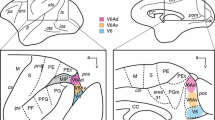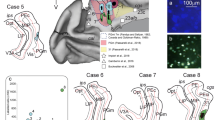Summary
Corticostriate projections from area 6 in the raccoon were studied using the autoradiographic tracing method. Following injections of tritiated amino acids into two different cytoarchitectonic subdivisions of area 6, widespread and dense anterograde label was found in both the ipsilateral and contralateral caudate nucleus and putamen. The densest label was located adjacent to the internal capsule in the lateral part of the head of the caudate nucleus. This bilateral projection pattern from area 6 to the caudate nucleus and putamen is consistent with the hypothesis that the neostriatum maintains a close anatomical and functional relationship with area 6.
Similar content being viewed by others
References
Beckstead RM (1984) The thalamostriate projection in the cat. J Comp Neurol 223: 313–346.
Bertrand G (1956) Spinal efferent pathways from the supplementary motor area. Brain 79: 461–473.
Brinkman C (1981) Lesions in supplementary motor area interfere with monkey's performance of a bimanual coordination task. Neurosci Lett 27: 267–270.
Brinkman C, Porter R (1979) Supplementary motor area in the monkey: activity of neurons during performance of a learned motor task. J Neurophysiol 42: 681–708.
Cowan WM, Gottlieb DI, Hendrickson AE, Price JL, Woolsey TA (1972) The autoradiographic demonstration of axonal connections in the central nervous system. Brain Res 37: 21–51.
Craig AD, Jr., Wiegand SJ, Price JL (1982) The thalamocortical projection of the nucleus submedius in the cat. J Comp Neurol 206: 28–48.
DiFiglia M, Pasik T, Pasik P (1978) A Golgi study of afferent fibers in the neostriatum of monkeys. Brain Res 152: 341–347.
Donoghue JP, Kitai ST (1981) A collateral pathway to the neostriatum from corticofugal neurons of the rat sensorymotor cortex: an intracellular HRP study. J Comp Neurol 201: 1–13.
Fisher RS, Shiota C, Levine MS, Hull CD, Buchwald NA (1984) Interhemispheric organization of corticocaudate projections in the cat: a retrograde double-labeling study. Neurosci Lett 48: 369–373.
Garcia-Rill E, Nieto A, Adinolfi A, Hull CD, Buchwald NA (1979) Projections to the neostriatum from the cat precruciate cortex. Anatomy and physiology. Brain Res 170: 393–407.
Glenn LL, Hada J, Roy JP, Deschenes M, Steriade M (1982) Anterograde tracer and field potential analysis of the neocortical layer I projection from nucleus ventralis medialis of the thalamus in cat. Neuroscience 7: 1861–1877.
Górska T (1974) Functional organization of cortical motor areas in adult dogs and puppies. Acta Neurobiol Exp 34: 171–203.
Hassler K, Mühs-Clement K (1964) Architektonischer Aufbau des sensomotorischen und parietalen Cortex der Katze. J Hirnforsch 6: 377–420.
Hendry SHC, Jones EG, Graham J (1979) Thalamic relay nuclei for cerebellar and certain related fiber systems in the cat. J Comp Neurol 185: 679–714.
Ilinsky IA, Kultas-Ilinsky K, Smith KR (1982) Organization of basal ganglia inputs to the thalamus. A light and electron microscopic study in the cat. Appl Neurophysiol 45: 230–237.
Jameson HD, Arumugasamy N, Hardin WB (1968) The supplementary motor area in the raccoon. Brain Res 11: 628–637.
Jones EG, Coulter JD, Burton H, Porter R (1977) Cells of origin and terminal distribution of corticostriatal fibers arising from sensory-motor cortex of monkeys. J Comp Neurol 173: 53–80.
Jürgens U (1984) The efferent and afferent connections of the supplementary motor area. Brain Res 300: 63–81.
Kemp JM, Powell TPS (1970) The cortico-striate projections in the monkey. Brain 93: 525–546.
Künzle H (1978) An autoradiographic analysis of the efferent connections from premotor and adjacent prefrontal regions (areas 6 and 9) in Macaca fascicularis. Brain Behav Evol 15: 185–234.
LaPlane D, Talairach J, Meininger V, Bancaud J, Orgogozo JM (1977) Clinical consequences of corticectomies involving the supplementary motor area in man. J Neurol Sci 34: 301–314.
Larsen KD, McBride RL (1979) The organization of feline entopeduncular nucleus projections: anatomical studies. J Comp Neurol 184: 293–308.
Morán A, Avendaño C, Reinoso-Suarez F (1982) Thalamic afferents to the motor cortex in the cat. A horseradish peroxidase study. Neurosci Lett 33: 229–233.
Neafsey EJ, Hull CD, Buchwald NA (1978a) Preparation for movement in the cat. I. Unit activity in the cerebral cortex. Electroenceph Clin Neurophysiol 44: 706–713.
Neafsey EJ, Hull CD, Buchwald NA (1978b) Preparation for movement in the cat. II. Unit activity in the basal ganglia and thalamus. Electroenceph Clin Neurophysiol 44: 714–723.
Oka H (1980) Organization of cortico-striate projections. Exp Brain Res 40: 203–208.
Pandya DN, Vignolo LA (1971) Intra and interhemispheric projections of the precentral, premotor and arcuate areas in the rhesus monkey. Brain Res 26: 217–233.
Royce GJ (1978) Cells of origin of subcortical afferents to the caudate nucleus: a horseradish peroxidase study in the cat. Brain Res 153: 465–475.
Royce GJ (1983) Single thalamic neurons which project to both the rostral cortex and caudate nucleus studied with the fluorescent double labeling method. Exp Neurol 79: 773–784.
Sakai ST, Tanaka D jr (1984) Contralateral corticothalamic projections from area 6 in the raccoon. Brain Res 299: 371–375.
Soltysik S, Hull CD, Buchwald NA, Fekete T (1975) Single unit activity in the basal ganglia of monkeys during performance of a delayed response task. Electroenceph Clin Neurophysiol 39: 65–78.
Tanaka D Jr, Górska T, Dutkiewicz K (1979) Differential projections to the neostriatum from the arm areas of the primary and supplementary motor cortices in the dog. Brain Res 172: 150–154.
Vedovato M (1978) Identification of afferent connections to cortical area 6aβ of cat by means of retrograde horseradish peroxidase transport. Neurosci Lett 9: 303–310.
Yamamoto T, Hassler R, Huber C, Wagner A, Sasaki K (1983) Electrophysiologic studies on the pallido and cerebellothalamic projections in squirrel monkeys (Saimiri sciureus). Exp Brain Res 51: 77–87.
Author information
Authors and Affiliations
Rights and permissions
About this article
Cite this article
Tanaka, D., Sakai, S.T. Corticostriate projections from area 6 in the raccoon. Exp Brain Res 58, 338–345 (1985). https://doi.org/10.1007/BF00235315
Received:
Accepted:
Issue Date:
DOI: https://doi.org/10.1007/BF00235315




